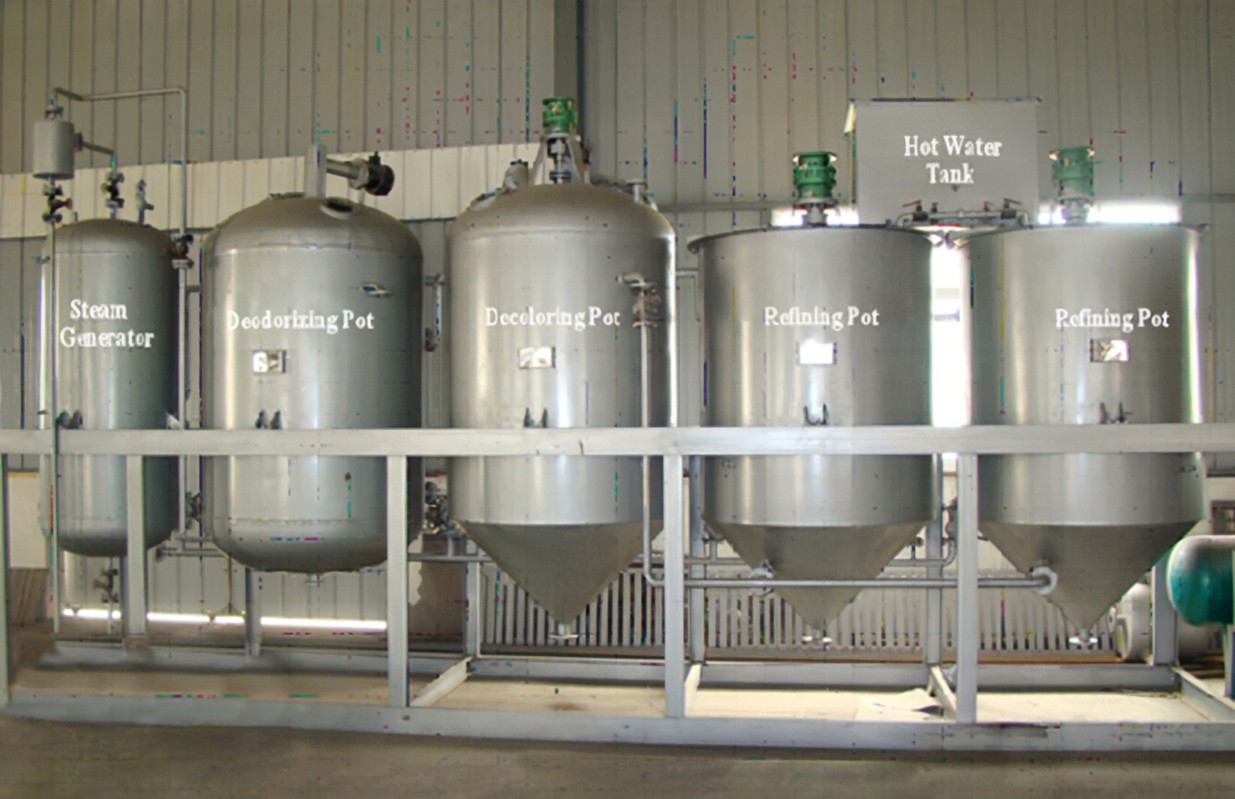
Small refining equipment is mainly suitable for the use of 1-20 tons/day projects. It has the characteristics of simple operation, easy maintenance, and low cost. At the same time, the small refining equipment also has a small area, quick effect, compact structure, fewer operators, and saving Energy and other advantages are the ideal choice for the majority of users.
Small-scale refining equipment is suitable for the refining of various vegetable oils. Crude oil is refined through alkali refining, degumming, deacidification, decolorization, and deodorization to the finished product. The oil quality can reach the national second-level oil (original high-grade cooking oil). Small refining equipment has low investment, quick results, compact structure and beautiful layout.
1. Application range of small refining equipment: rapeseed oil, sunflower oil, tea seed oil, soybean oil, peanut oil and other vegetable oils.
2. Small refining equipment mainly consists of the following equipment
Oil refining pot: used for acid refining, alkali refining and water washing.
Decolorizing pot: used for bleaching grease and depigmenting.
Deodorizing pot: used to remove the odor of grease.
Heat conduction oil furnace: Provide heat energy required for production.
Vacuum pump: Provides the vacuum required for decolorization and deodorization.
Air compressor: Blow-dry the decolorized clay and press out the finished oil.
Filter: filter white clay.
Steam generator: produces steam required for deodorization distillation.
3. Process flow of small refining equipment: crude oil → alkali refining → water washing → decolorization → deodorization → refined oil
Fourth, the operation process of small refining equipment:
The crude oil is pumped into the oil refining tank of the refining equipment for degumming and neutralization operations. When the oil and soap separate and sink quickly, stop stirring and start to stand still. The upper clear oil is sucked out to the washing tank, the soapstock is put into the soapstock bucket from the bottom emptying tube, when the soapstock contains more oil, the soapstock is stopped, and the soapstock is pumped into the soapstock tank. The remaining oil in the refinery tank is mixed into the next tank to continue. The clean oil transferred from the refining tank is washed with water and then sent to the decolorization tank for adsorption decolorization. The clean oil transferred from the refining tank is washed with water and then sent to the decolorization tank for adsorption and decolorization. The decolorized oil is filtered with a plate and frame filter, and then further filtered with a polishing filter. After being cooled by a cooler, it enters the decolorization and clear oil tank.
The decolorized oil is pumped into the gas separator at a constant flow rate through a pump, and the flow rate of the oil is adjusted by a flow meter. In the gas separator, the oil is sprayed out through multiple nozzles on the feed pipe, and the high vacuum degree of the absolute pressure of about 3 mmHg is maintained in the gas separator to release a small amount of air infiltrated in the oil. The oil comes out of the gas separator, is pumped into the oil-oil heat exchanger, exchanges heat with the hot oil from the deodorization tower, and is heated to at least 180°C. From the oil-oil heat exchanger, the oil flows into the heat-conducting oil heater and is heated to 260°C. The heat-conducting oil is heated to 290°C in the heat-conducting oil furnace and is recycled throughout the process. The hot oil to be deodorized enters the combined deodorization tower from the heat-conducting oil heater, where fatty acids and other relatively volatile odor substances are stripped out by direct steaming in the packing section, and then enters the plate section for deodorization and thermal decolorization. When processing oils with low acid value or low requirements for the acid value of the finished oil, it is possible to directly enter the plate section for deodorization and thermal decolorization without passing through the packing section. Deacidification and deodorization are operated under a vacuum state of high temperature and 3mmHg absolute pressure. The vacuum is generated and maintained by a four-stage vacuum pump system. The deacidified and deodorized oil is discharged from the combined deodorization tower, pumped into the heat exchanger to exchange heat with the oil to be deodorized, and then enters the cooler, where it is cooled by water. After cooling, the oil temperature is not higher than 70℃, and then passes through the fine filter. , Carry out insurance filtering, and then store in the refined oil storage tank.
For deodorized oils with high fat (wax) content such as tea seed oil, rice bran oil, and corn germ oil, further dewaxing and degreasing should be carried out.
Copyright © Henan Zhongxing Grain And Oil Machinery Co.,Ltd. All Rights Reserved. Powered by MetInfo